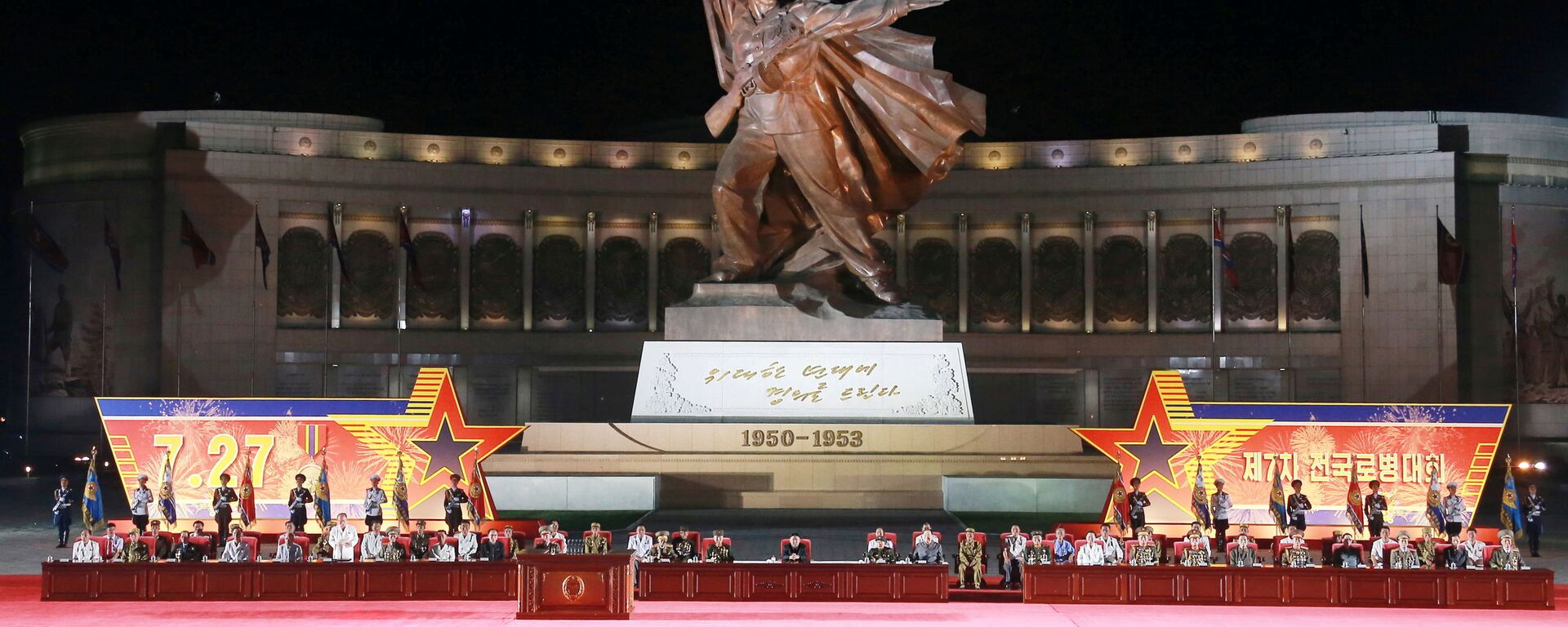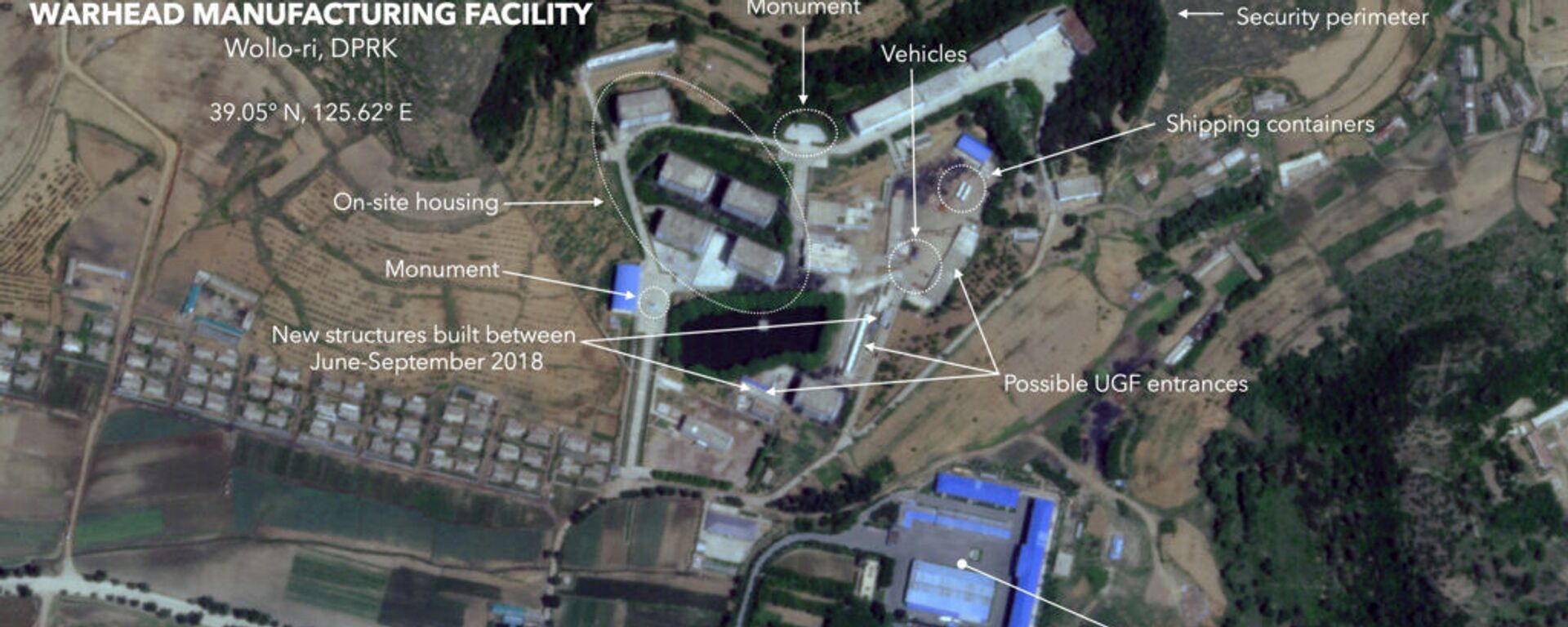https://sputnikglobe.com/20210919/satellite-snaps-appear-to-show-expansion-of-north-koreas-nuclear-bomb-making-capabilities-1089217861.html
Satellite Snaps Appear to Show Expansion of North Korea’s Nuclear Bomb-making Capabilities
Satellite Snaps Appear to Show Expansion of North Korea’s Nuclear Bomb-making Capabilities
Sputnik International
The Stockholm International Peace Research Institute estimates that the Democratic People’s Republic of Korea (DPRK) has as many as 50 nuclear warheads in its... 19.09.2021, Sputnik International
2021-09-19T19:07+0000
2021-09-19T19:07+0000
2023-09-18T13:34+0000
nuclear
uranium
north korea
https://cdn1.img.sputnikglobe.com/img/106008/20/1060082056_0:186:3001:1874_1920x0_80_0_0_366a9d2f42492a7669a84385ad040209.jpg
North Korea is expanding the capabilities of its Yongbyong nuclear complex, with the expansion expected to increase the country’s weapons-grade uranium making capabilities by up to a quarter, a US expert analyzing new satellite images has alleged.The satellite images, published by private US-based earth imaging company Maxar, were analyzed by the Middlebury Institute of International Studies at Monterey, a California-based graduate school.The analyst estimates that North Korea could house at least “1,000 additional centrifuges” in the new space, with this capacity increasing the plant’s ability to produce highly enriched uranium “by as much as 25 percent.”Two sources told CNN that US officials are aware of Yongbyon’s possible expansion, and acknowledged that the construction could mean that the country is working to expand its weapons-grade uranium production capabilities.Lewis asterisked the “1,000 new centrifuges” claim in his new report, saying that his calculations assume “that North Korea continues to operate early-generation centrifuges seen since 2010, an assumption that should be treated with caution.” He suggested that if the country were to replace its centrifuges with more advanced models, “as Iran has done, this could increase the capacity of the plant substantially.”North Korea’s Nuclear PolicyNorth Korean leader Kim Jong-un ordered the expansion of the country’s nuclear capabilities at the ruling Workers’ Party Congress in January, lauding the “great cause of building a [domestic] nuclear force” and urging the defense industry to “develop nuclear technology to a higher level and make nuclear weapons smaller and lighter for more tactical uses” while allowing the country to “continuously push ahead with the production of super-sized nuclear warheads.”The Stockholm International Peace Research Institute estimates that the DPRK has about 30-50 nuclear warheads in its arsenal, and the means to deliver them.Pyongyang carried out fresh ballistic missile tests on Wednesday, saying its new railway-borne missile system would serve “as an efficient counter-strike means capable of dealing a harsh multi-concurrent blow to threat-posing forces.”The test of the rail-based missiles followed the DPRK’s announcement a week earlier that it had successfully tested a new long-range cruise missile able to strike targets about 1,500 km away.North Korea considers its nuclear weapons capability to be a key plank of its deterrent against US and South Korean aggression. The country has promised that its weapons “will never be abused or used as a means for preemptive strike,” but has also warned that the nukes may be used in case of a military attack against the country.Last year, the country showed off a never-before-seen intercontinental ballistic missile system with the suspected capability of striking the continental United States. The system is believed to be a successor to the Hwasong-15, a liquid-fueled missile that can travel up to 13,000 km to its target.During his presidency, Donald Trump attempted to take steps to improve ties with Pyongyang and reduce nuclear tensions, with the ultimate goal including the demilitarization of the Korean peninsula and the curbing of North Korea’s nuclear programme. Trump and Kim Jong-un established a personal rapport and met several times, but no firm agreements were reached, with Pyongyang categorically rejecting a push by the US for the elimination of its nuclear deterrent.Relations between North Korea and the US have worsened under the Biden administration, with Pyongyang urging Washington to drop the “lunatic theory of [the] ‘threat from North Korea and groundless rhetoric about complete denuclarization.” Joe Biden helped to establish an atmosphere of tensions by criticizing Trump for meeting with Kim, and by characterizing the North Korean leader as a “thug,” “tyrant” and “dictator.” North Korea responded by calling Biden an “imbecile” and a “rabid dog” that “must be beaten to death with a stick.”
https://sputnikglobe.com/20200709/spy-satellite-reportedly-spots-new-nuclear-site-in-north-korea-amid-freeze-in-trump-kim-talks-1079840462.html
https://sputnikglobe.com/20210916/north-korea-touts-its-railway-borne-missile-system-to-deal-harsh-blow-to-threat-posing-forces-1089120072.html
https://sputnikglobe.com/20210909/hazmat-suits-no-nukes-and-slim-kim-jong-un-north-korea-holds-parade-on-73rd-foundation-day-1088912228.html
north korea
Sputnik International
feedback@sputniknews.com
+74956456601
MIA „Rosiya Segodnya“
2021
News
en_EN
Sputnik International
feedback@sputniknews.com
+74956456601
MIA „Rosiya Segodnya“
Sputnik International
feedback@sputniknews.com
+74956456601
MIA „Rosiya Segodnya“
nuclear, uranium, north korea
nuclear, uranium, north korea
Satellite Snaps Appear to Show Expansion of North Korea’s Nuclear Bomb-making Capabilities
19:07 GMT 19.09.2021 (Updated: 13:34 GMT 18.09.2023) The Stockholm International Peace Research Institute estimates that the Democratic People’s Republic of Korea (DPRK) has as many as 50 nuclear warheads in its arsenal. The country has a number of medium-, long- and ultra-long-range missiles able to deliver blows to almost any part of the world, including any point in the continental United States.
North Korea is expanding the capabilities of its Yongbyong nuclear complex, with the expansion expected to increase the country’s weapons-grade uranium making capabilities by up to a quarter, a US expert analyzing new satellite images has alleged.
The satellite
images, published by private US-based earth imaging company Maxar, were analyzed by the Middlebury Institute of International Studies at Monterey, a California-based graduate school.
Jeffrey Lewis, a professor at the Middlesbury Institute specializing in arms control, released a
report on the activities at the suspected nuclear site, suggesting that “the most recent expansion at Yongbyon,” which he estimated to comprise of about 1,000 square meters of new space, “probably reflects plans to increase production of nuclear materials for weapons production.”
The analyst estimates that North Korea could house at least “1,000 additional centrifuges” in the new space, with this capacity increasing the plant’s ability to produce highly enriched uranium “by as much as 25 percent.”
Two sources
told CNN that US officials are aware of Yongbyon’s possible expansion, and acknowledged that the construction could mean that the country is working to expand its weapons-grade uranium production capabilities.
The Middlebury Institute regularly
monitors the Yongbyon plant, and North Korea’s nuclear and missile-related activities in general, but has been known to be mistaken in its findings in the past. Last year, an institute report on a potential ‘undeclared’ North Korean nuclear facility outside Pyongyang said to be used to build nuclear warheads was later
revealed to be an officer training school instead.
Lewis asterisked the “1,000 new centrifuges” claim in his new report, saying that his calculations assume “that North Korea continues to operate early-generation centrifuges seen since 2010, an assumption that should be treated with caution.” He suggested that if the country were to replace its centrifuges with more advanced models, “as Iran has done, this could increase the capacity of the plant substantially.”
North Korea’s Nuclear Policy
North Korean leader Kim Jong-un
ordered the expansion of the country’s nuclear capabilities at the ruling Workers’ Party Congress in January, lauding the “great cause of building a [domestic] nuclear force” and urging the defense industry to “develop nuclear technology to a higher level and make nuclear weapons smaller and lighter for more tactical uses” while allowing the country to “continuously push ahead with the production of super-sized nuclear warheads.”
The Stockholm International Peace Research Institute
estimates that the DPRK has about 30-50 nuclear warheads in its arsenal, and the means to deliver them.
Pyongyang carried out fresh ballistic missile tests on Wednesday, saying its new railway-borne missile system would serve
“as an efficient counter-strike means capable of dealing a harsh multi-concurrent blow to threat-posing forces.”

16 September 2021, 08:34 GMT
The test of the rail-based missiles followed the DPRK’s announcement a week earlier that it had successfully tested a new long-range cruise missile able to strike targets about 1,500 km away.
North Korea considers its nuclear weapons capability to be a key plank of its deterrent against US and South Korean aggression. The country has promised that its weapons “will never be abused or used as a means for preemptive strike,” but has also warned that the nukes may be used in case of a military attack against the country.
Last year, the country showed off a never-before-seen intercontinental ballistic missile system with the suspected capability of striking the continental United States. The system is believed to be a successor to the Hwasong-15, a liquid-fueled missile that can travel up to 13,000 km to its target.

9 September 2021, 11:31 GMT
During his presidency, Donald Trump attempted to take steps to improve ties with Pyongyang and reduce nuclear tensions, with the ultimate goal including the demilitarization of the Korean peninsula and the curbing of North Korea’s nuclear programme. Trump and Kim Jong-un established a personal rapport and met several times, but no firm agreements were reached, with Pyongyang categorically rejecting a push by the US for the elimination of its nuclear deterrent.
Relations between North Korea and the US have worsened under the Biden administration, with Pyongyang urging Washington to drop the “lunatic theory of [the] ‘threat from North Korea and groundless rhetoric about complete denuclarization.” Joe Biden helped to establish an atmosphere of tensions by criticizing Trump for meeting with Kim, and by characterizing the North Korean leader as a “thug,” “tyrant” and “dictator.” North Korea responded by calling Biden an “imbecile” and a “rabid dog” that “must be beaten to death with a stick.”






